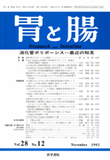Japanese
English
- 有料閲覧
- Abstract 文献概要
- 1ページ目 Look Inside
要旨 Peutz-Jeghers(PJ)ポリープ90個と若年性ポリポーシスまたはポリープ34個に対し,各種粘液染色,増殖細胞指標のKi-67染色,筋特異性アクチン・Ki-67二重染色,およびp53免疫染色を行い,ポリープの主な構成上皮の種類,形態形成機序,樹枝状平滑筋束の形成機序とポリープ内での腫瘍形態発生を検討した.PJポリープは主に,胃では成熟型腺窩上皮の過形成(増殖帯長は正常~短縮,固有胃腺は萎縮),小腸では成熟型絨毛上皮の過形成(増殖帯長は正常~短縮,陰窩長はほぼ正常),大腸では成熟型粘液上皮(増殖帯上方の上皮)の過形成(増殖帯長は短縮)から成っていた.粘膜筋板や樹枝状平滑筋束の平滑筋細胞は筋特異性アクチン陽性,Ki-67陰性であった.PJポリープでは上皮過形成が小区画性にみられ,それらが憩室様に粘膜下層へ侵入し,小区画間の粘膜筋板は粘膜側へ凸に屈曲し,ついには融合することで,樹枝状平滑筋束が形成されていた.このほかに,胃PJポリープでは粘膜内の平滑筋束(肥大平滑筋から成る)が樹枝状平滑筋束を形成することもあった.いずれの場合でも,平滑筋は新生されたものではなく,既存のものが肥大したものであった.胃若年性ポリポーシスは腺窩上皮の過形成を主体とし,増殖帯長は延長ないし正常で,幽門腺は正常ないし増生,胃底腺は偽幽門腺化生を示した状態で,幽門腺の状態と近似していた.間質拡大はポリープ表層部のみで,それ以下は狭い間質である点が小腸・大腸の若年性ポリープと異なっていた.小腸・大腸若年性ポリープは,粘膜固有層表層部の浮腫・血管拡張・炎症細胞浸潤に続いて,増殖帯とその上方部分の延長が初期像であった.次いで,粘膜全層に及ぶ間質拡大,延長増殖帯の分断・分岐・蛇行や新生腺管がみられ,腺開口部の障害と腺上皮増加で,腺管の囊胞化,大小不同,不規則配列が形成されていた.PJポリープや若年性ポリープ内での腫瘍化は増殖帯で起こり,腫瘍細胞は非腫瘍細胞の管腔側への移動と共に,管腔側へ移行しながら増殖し,これらのポリープの増殖帯から離れた位置のポリープ表層に,腫瘍性病変を形成すると考えられた.
The morphogenesis, main epithelial component and initial sites of neoplasm of Peutz-Jeghers (PJ) polyps and juvenile polyps, and synthetic mechanism of arborizing smooth muscle bundles in PJ polyps were analized using various mucous stains, Ki-67 (marker of proliferative cells), muscle specific actin (MSA) and Ki-67 double stain, and p53 immuno-stain on 90 PJ polyps and 34 juvenile polyps (endoscopically or surgically resected material). PJ polyp was mainly composed of hyperplasia of mature foveolar epithelium (with atrophy of proper glands and normal or shorter proliferative zones) in the stomach, hyperplasia of mature villous epithelium (with almost normal crypt and normal or shorter proliferative zones) in the small intestine, and hyperplasia of mature mucous epithelium above the proliferative zones (which is shorter than the normal) in the large intestine.
The PJ polyps consisted of compartments of some hyperplastic glands growing in the mucosa or growing down toward the submucosa with diverticulum-like appearance. The preexisting mucularis mucosae between the compartments bent upward and at last reduplicated, or the preexisting muscle bundles in the mucosa, particularly in the gastric mucosa, were compressed aside by the hyperplastic epithelial components. The arborizing muscle bundles are suggested to be formed through these processes. The muscle cells in the bundles were hypertrophic, but not newly formed by cell-proliferation, because they were positive for MSA and negative for Ki-67.
Gastric juvenile polyposis showed foveolar-cell hyperplasia, elongation of the foveolae, elongated or normal proliferative zone, normal or increased pyloric glands and pseudopyloric gland metaplasia of fundic glands. Enlargement of the stroma was observed in the superficial part of the mucosa, but not in the deeper. We have no experiences of early phase of gastric juvenile polyps.
On the other hand, early juvenile polyps of the small and large intestine revealed edema, vascular dilatation, inflammatory infiltration and ensuing elongation of the proliferative zones and the upper tubules above the zone. The full-developed histological features were enlargement of the stroma of the whole mucosa, and new glands derived from branching and separation of the elongated proliferative zones. These tubules showed cystic appearance, variety in size and irregular arrangement which may be induced by obstruction of glandular orifice and proliferation of epithelial cells. Neoplastic cells in PJ polyps or juvenile polyps are suggested to initially arise from the proliferative zone of these polyps, migrate to the luminal side with non-neoplastic cells, and finally exist at the surface of the polyps that is far from the original proliferative zones.

Copyright © 1993, Igaku-Shoin Ltd. All rights reserved.


